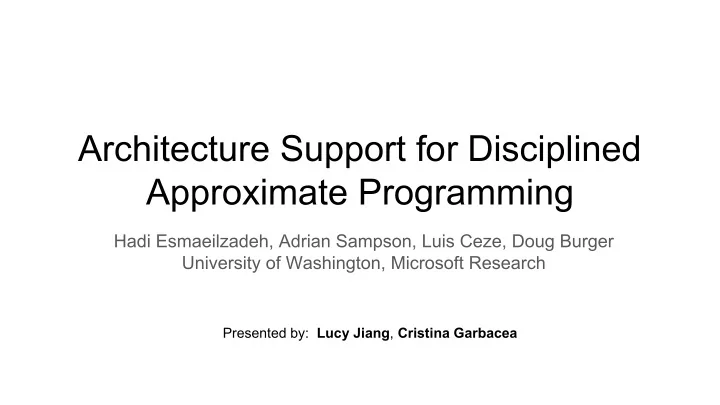

Architecture Support for Disciplined Approximate Programming Hadi Esmaeilzadeh, Adrian Sampson, Luis Ceze, Doug Burger University of Washington, Microsoft Research Presented by: Lucy Jiang , Cristina Garbacea
Outline ● Background ● Truffle: A Dual-Voltage Microarchitecture for Disciplined Approximation ● Evaluation ● Conclusion
Background Goal Reducing energy usage + Increasing energy efficiency Trading off quality of service to energy efficiency using General Solution approximate computation Proposed Approximation-aware Disciplined approximate Solution microarchitecture programming models Help programmers identify soft slice
Architecture Proposal Microarchitectural Allow a compiler to convey ISA Extension what can be approximated extensions To Rely on Processors that A dual voltage supply for SRAM implement the ISA arrays and logic HIGH LOW Vdd Vdd
ISA Extensions for Approximation ● ISA supports both operations. ○ Precise: correct output guaranteed ○ Approximate: correct output expected ● Programming language assumption ○ Approximate doesn’t affect precise ● Precision of registers ○ Depending on the last instruction ○ Every instruction has an extra bit per operand to specify precision
Esmaeilzadeh, Hadi, Adrian Sampson, Luis Ceze, and Doug Burger. "Architecture support for disciplined approximate programming." In ACM SIGPLAN Notices, vol. 47, no. 4, pp. 301-312. ACM, 2012. Truffle: Dual-Voltage SRAM Structure
Esmaeilzadeh, Hadi, Adrian Sampson, Luis Ceze, and Doug Burger. "Architecture support for disciplined approximate programming." In ACM SIGPLAN Notices, vol. 47, no. 4, pp. 301-312. ACM, 2012. Truffle: Voltage Level Shifting and Multiplexing
Esmaeilzadeh, Hadi, Adrian Sampson, Luis Ceze, and Doug Burger. "Architecture support for disciplined approximate programming." In ACM SIGPLAN Notices, vol. 47, no. 4, pp. 301-312. ACM, 2012. Truffle Execution
Evaluating Truffle Goals: ● Determine the energy savings brought by disciplined approximation ● Characterize where the energy goes ● Understand the QoS implications for software
Evaluation Setup - Truffle is modeled at 65 nm technology node in the context of both in-order and out-of-order designs - Evaluate each benchmark for two criteria: energy savings and sensitivity to error - Statistics collected: variable, field, array accesses, basic blocks, arithmetic and logical operators - Inject errors in the execution and measure the consequent degradation in output quality
Evaluation Setup Benchmarks: - 9 benchmark programs written in EnerJ: hand-annotated programs with approximate type qualifiers that distinguish their approximate parts (SciMark2, ZXing, jMonkeyEngine, ImageJ, 3D raytracer) - How to quantify the loss in output quality caused by hardware approximation? Define an application specific quality-of-service metric to quantify the loss in output quality RMSE ❖ ❖ Proportion of incorrect intersection decisions Proportion of unsuccessful decodings of a sample QR code image ❖
Energy Savings V dd H = 1.5 V V dd L : 50%, 62.5%, 75%, 87.5% of V dd H Frequency = 1666 MHz - in-order configuration: all voltage levels lead to energy savings (up to 43%) - out-of-order configuration: energy savings when V dd L is less than 75% of V dd H The impact of Truffle in in-order cores is much higher!
Energy Breakdown Per Component Out-Of-Order Truffle In-Order Truffle Imagefill: 42% (OOO) and 47% (In-Order) of energy is consumed in data movement/processing plane Raytracer: 71% (OOO) and 50% (In-Order)
Energy Savings Potential - reduce the voltage level of the instruction control plane to 1.2 V V dd L = 0.75 V - the gap in energy savings potential between the OOO and in-order designs is significantly reduced.
Error Propagation from Circuits to Applications - Inject errors in each of the microarchitectural structures that support approximate behaviour
Conclusion - Disciplined approximate programming is an effective and usable technique for trading off correctness guarantees with energy savings - Dual-voltage microarchitectures can provide both approximate and precise computation controlled at a fine-grain by the compiler; ISA relies on the compiler to eliminate the need for checking or recovery at run time - Truffle presents energy savings up to 43% under reasonable assumptions, with benchmarks exhibiting negligible degradation in output quality.
Discussion points 1. For approximation, should we rely more on hardware support or software support? Why? 2. Is Truffle practical enough to be implemented in real world applications? 3. What kind of applications are suitable for disciplined approximate programming using this microarchitecture?
Recommend
More recommend